Algarrobo and Dry Forest Conservation in Northern Peru
29,000 hectares of dry forest are lost each year in Piura, northern Peru. Shocking statistics such as these tend to refer to large areas of the Amazon rainforest, chopped down and replaced with agriculture and industry where dense, green expanses once stood. However, the tropical rainforests are not the only forests under threat in Peru. 90% of the original extent of Peruvian dry forests has already been lost, making it the most endangered ecosystem in Latin America.
These dry forests naturally consist of an array of native flora and fauna, but the tree under the spotlight as of late is the Algarrobo (Prosopis pallida), indigenous to South America. This amazing tree thrives in dry coastal areas, thanks to its impressive efficiency at extracting moisture from soil in dry climates prone to drought, and provides habitat to a variety of indigenous wildlife.
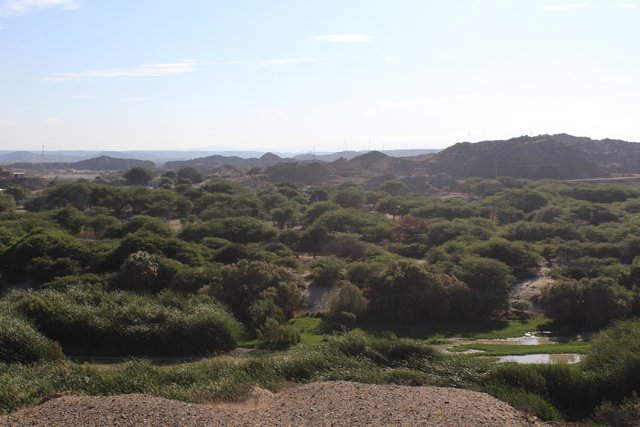
The dry forest ecosystem of northern Peru
Despite these unique adaptations, the Algarrobo is severely under threat from illegal logging for fuel, forest fires, invasive species, climate change and plagues. Threats such as these inevitably are leading to, not only vast losses in biodiversity but they also put at risk the livelihoods of over 40,000 rural families who depend on its resources.
In an effort to bring attention to this issue, in April 2019, la Universidad Nacional de Piura held a conference entitled “Salvemos nuestro Algarrobo”. It was a morning full of informative talks from various researchers at the university and local government bodies and organisations, providing insight into the importance of the algarrobo tree and innovative solutions to their conservation. Not wanting to miss an opportunity to learn more about how we can protect our local ecosystem, three members of the EcoSwell team, Michael Alderson (Director), Ellen Jones (Volunteer & Projects Supervisor) and Ezra Kraus (Reforestation Intern) went to the event in Piura in order to find out more about how we can work towards conserving the endangered Algarrobo in our own reforestation projects in Lobitos and Piedritas.
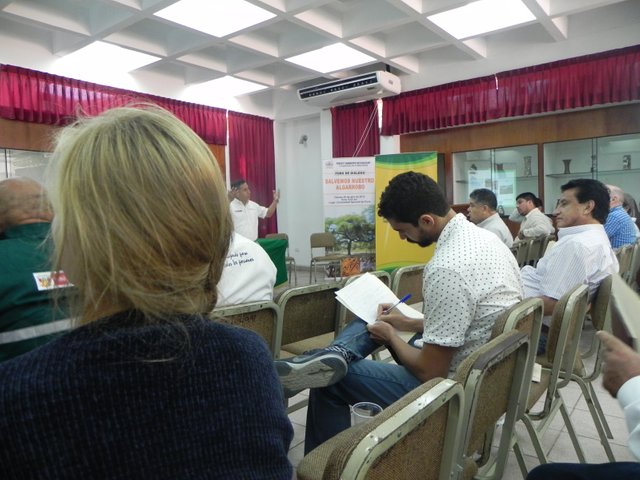
EcoSwell director Michael taking notes during the conference
One of the opening speakers was Ana Juárez, a biologist from the Universidad Nacional Pedro Ruíz Gallo in Lambayeque. She began by presenting us with various aerial images of Peruvian dry forests over a period of time which showed areas of healthy green vegetation but also patches of dark, leafless trees. She identified these dead trees as being almost all algarrobos. But if these trees are so well adapted to the dry arid climate, why are the algarrobos dying while other species continue to flourish?
A plague, she states, known as Enallodiplosis discordis, is one of the main culprits for the deaths of many algarrobos in this region. The larvae of the tiny insects feed off the sap of the tree, drying up the leaves and turning the leaves a yellow colour. The larvae fall to the soil where they reproduce and the cycle continues, slowly draining the algarrobo of life.
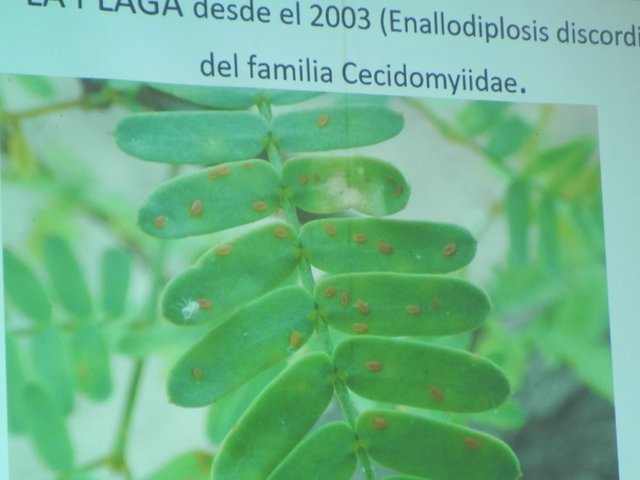
An image of the plague on the leaves of the algarrobo.
But what can we do about this? Are there solutions already in place to protect and conserve the algarrobos?
In response to such questions, many ideas about how we can prevent the degradation of the dry forests were discussed in depth throughout the rest of the conference, like:
- Political legislation needs to be put in place and enforced to protect significant areas of forest. There are currently five designated protected areas of dry forest in Piura alone but more widespread legislation needs to be politically enforced in order to prevent the continued exploitation of the forests.
- More research and monitoring needs to be conducted to compliment the existing academia in order to better understand the extent of how and WHY climate change and plagues are impacting the dry forests.
- It’s all very well protecting the land from human interference, but we must also consider the people who depend on the dry forest for their livelihoods. One way to achieve this is through the establishment of alternative sources of income for the rural population to discourage illegal logging for fuel and encourage tree conservation. For example, many campesinos are raising livestock such as grazing goats for local cheese production which can be used to maintain the health of algarrobo trees. The goats eat the leaves that contain any eggs and larvae of parasitic insects, consequently lowering the presence of the plague in algarrobo populations. Additionally, there are various local organisations working alongside communities to produce sustainable, organic algarrobo-based products such as Productos Agricolas del Alto Piura (PAAP) which produces algarrobina honey which are rich in nutrients and vitamins (we bought some algarrobo products after the event, including algarroba toffee!)
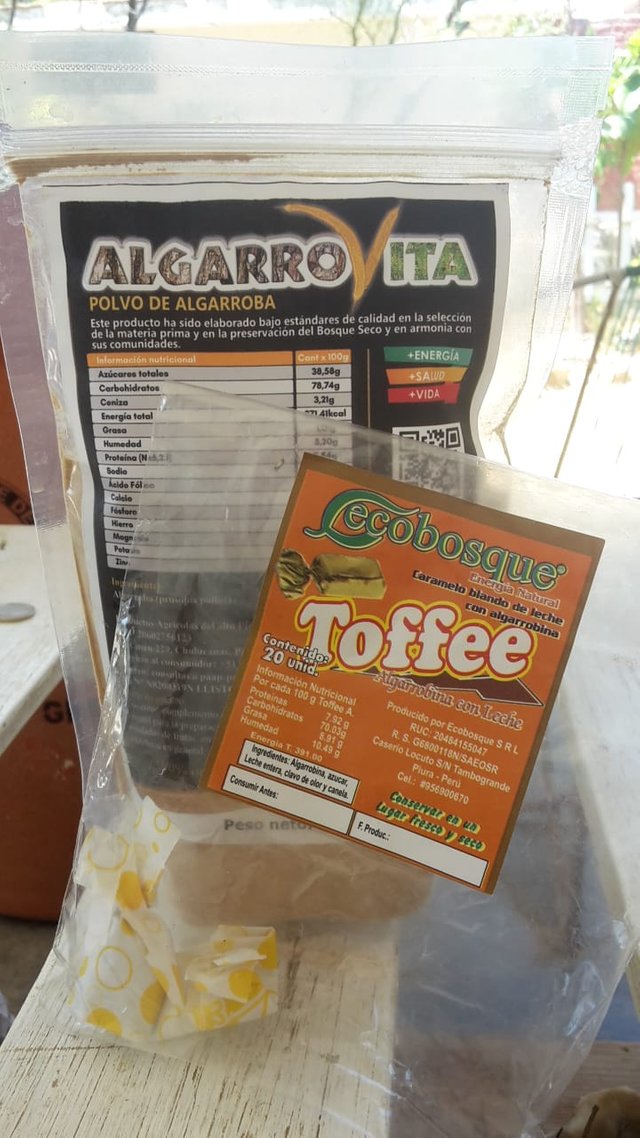
Algarrobo flour made from the fruit that the tree produces and algarrobina toffee (which got eaten really fast!)
At the end of the speeches, we had an opportunity to ask questions to the panel. What we really wanted to know was what can we, as an NGO, do in terms of immediate action? Placing rocks below the trees prevent the plague from reproducing in the soil, thus disrupting its lifecycle. Her main take home message, however, was that we must begin collecting the seeds in order to create seed banks and nurseries in order to actively reforest degraded land whilst protecting and conserving the older trees at the same time. At EcoSwell, we are already planting a variety of native trees, such as the algarrobo, both in the nursery at the EcoHouse, our own dry forest and with the communities of Lobitos and Piedritas as part of our reforestation projects. In Lobitos we have reforested a derelict area of land with over 260 native species and are carrying out community greening with around 60 families and establishing biodiversity awareness through educational workshops. We also have been working with the nearby community in Piedritas through the development of ecotourism in order to reduce the reliance of illegal logging and charcoal production and we are carrying out more community greening with 20 families.
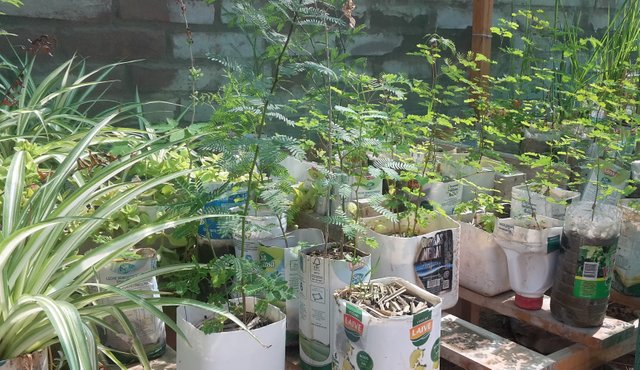
The EcoSwell nursery where we grow algarrobo seedlings and other native and non-native plants to plant in the dry forest or with local families in the community.
Overall, it was a great networking opportunity and we were able to meet and talk to many researchers and entrepreneurs who are working together to save our algarrobo in northern Peru. Many of the speakers and representatives present at the event already knew about EcoSwell and our work, so it was incredible to speak to so many people who appreciated what we are working towards in Lobitos and who were keen to form working connections with us and get involved.
Despite the challenges of plagues, logging and a changing climate, this event provided us with insight into the extent of the issues and what we can begin to do in order to protect and conserve the algarrobo and dry forests in the region. Effective collaboration must be implemented and maintained between all stakeholders and communities in order to successfully protect our algarrobos. Events such as these are a great way to bring people, government bodies, NGOs and other organisations together to begin raising awareness of and sharing solutions to environmental issues. At EcoSwell, we are proud to be a part of this collaborative movement in conserving and protecting our precious dry forest ecosystems and we are very excited to begin applying more conservation initiatives to our projects.
Special thanks to those who organised and presented at the event in Piura. Now let’s go and save our Algarrobo!
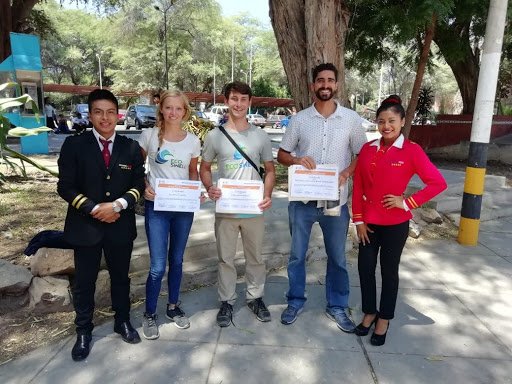
Ellen (Volunteer & Projects Supervisor), Ezra (Reforestation Intern) & Michael (Director) with their certificates and staff members after attending the conference.
Congratulations @ecoswell! You have completed the following achievement on the Steem blockchain and have been rewarded with new badge(s) :
You can view your badges on your Steem Board and compare to others on the Steem Ranking
If you no longer want to receive notifications, reply to this comment with the word
STOPVote for @Steemitboard as a witness to get one more award and increased upvotes!